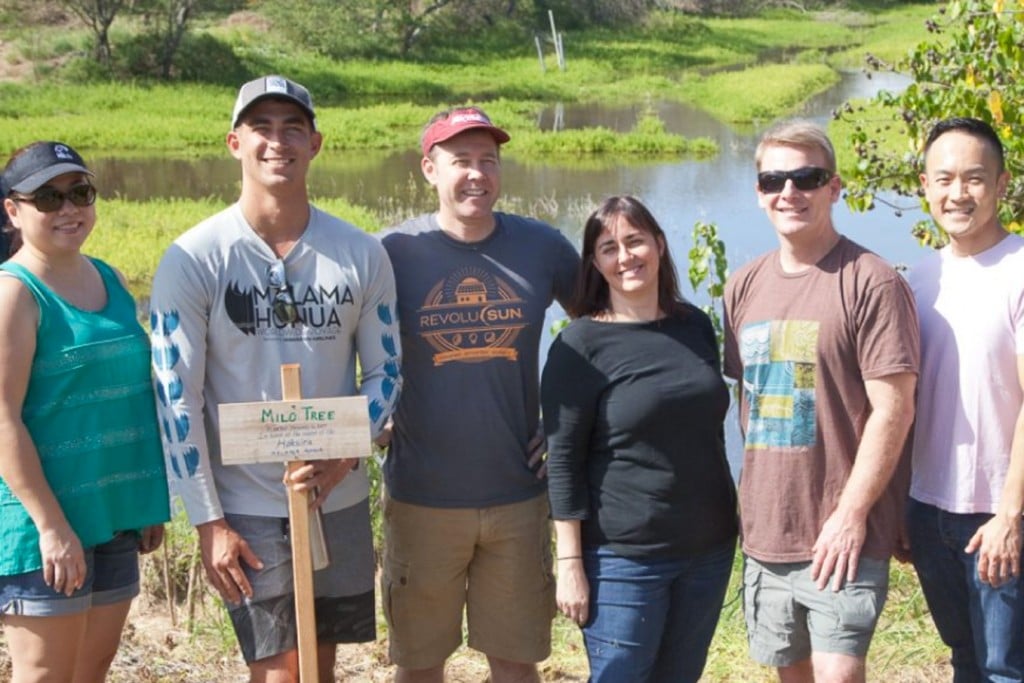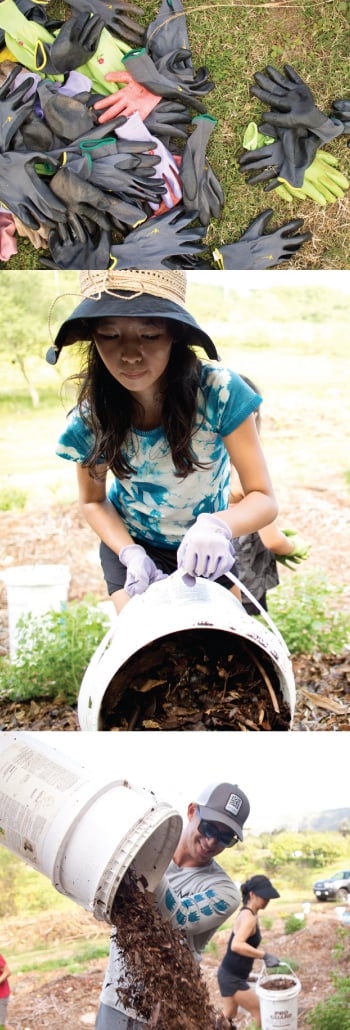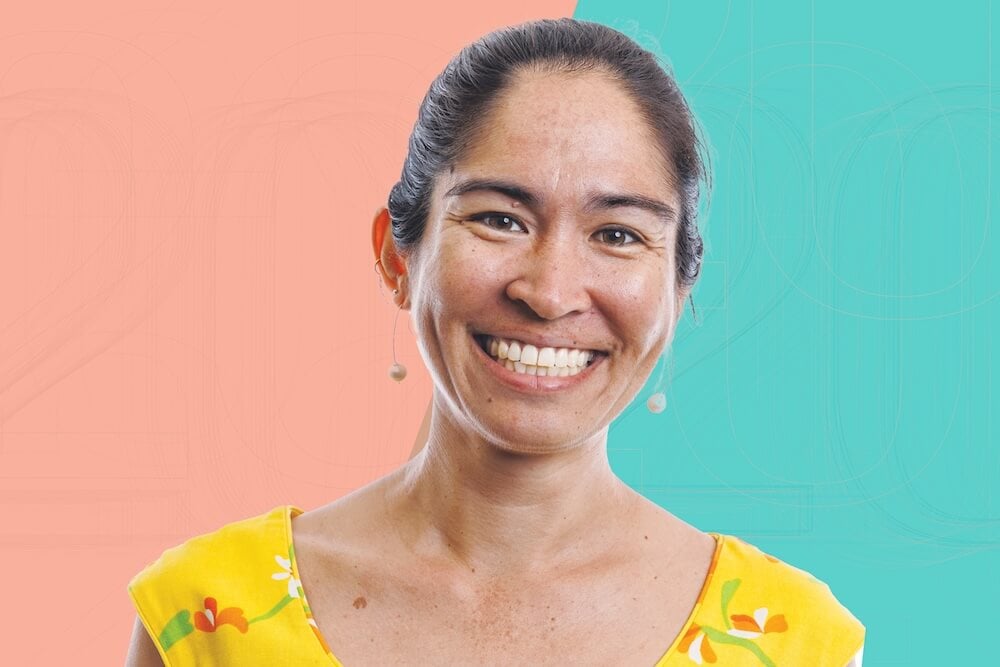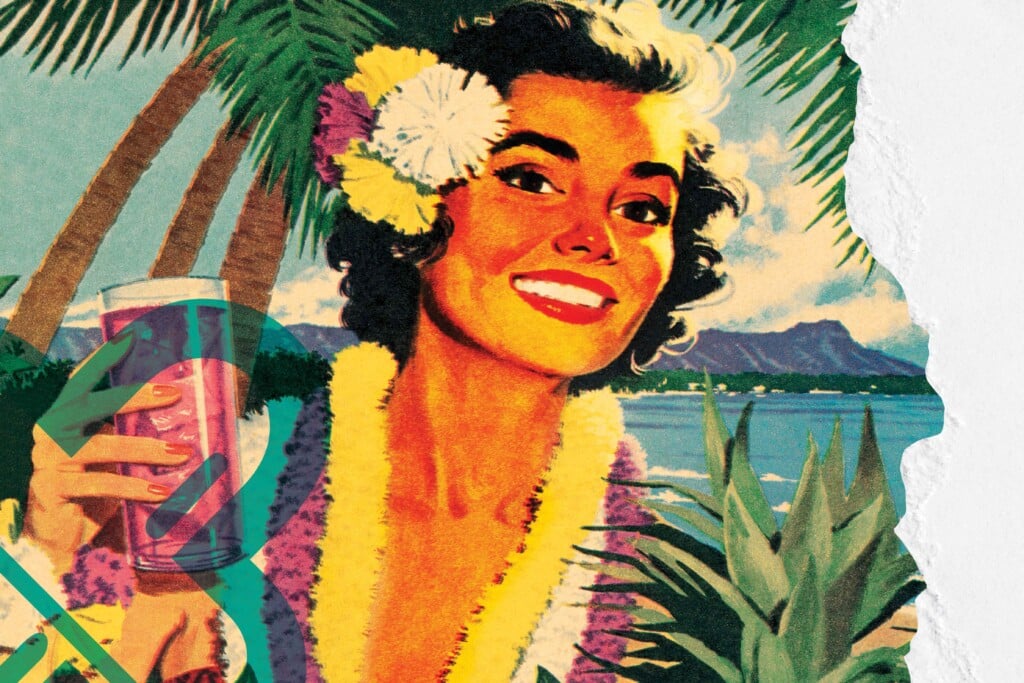20 for the Next 20 Community Project: Giving Back

Despite being sandwiched between a busy road and a thoroughly non-native hillside, Oahu’s Hamakua Marsh is home to some of Hawaii’s rarest birds, including the red-plated Hawaiian moorhen, or alae ula, which is federally listed as endangered.

Photos by Jeff Hawe
Protected by little more than a chainlink fence on the mauka side of Kailua town, the wetland has been a bird sanctuary for almost 20 years. In that time, wildlife biologists at Hawaii’s Department of Land and Natural Resources have seen a remarkable increase in the number of rare bird species here, proof that even small efforts can make a big difference.
That was also the takeaway from a recent workday at Hamakua, when about half of the 2016 class of Hawaii Business’ 20 for the Next 20 spent an afternoon working to help realize Hamakua’s next phase. With the wetland functioning relatively well, DLNR and its partners have begun focusing on reforestation, replacing the aggressive hale koa that blankets the Puuoehu hillside with native milo and hala trees.
This type of community project has become an annual tradition for the 20 for the Next 20. Although the initiative is only in its second year, Colin Yost, COO of Revolusun, said it distinguishes the program from other honors.
“The 20 for the Next 20 has none of the program infrastructure of either the Pacific Century Fellows or the Omidyar Fellows, which are very intensive and are great programs,” he said. “And yet it could actually punch above its weight if it encourages this sort of thing.”
By placing “an expectation on members of the class to come up with something real and significant,” he said, the program “inspires action.”
Yost spearheaded the group’s planting efforts at Hamakua. The group chose to partner with Lisa Marten, of Healthy Climate Communities, who, for the past three years, has worked alongside DLNR’s Division of Forestry and Wildlife on the reforestation.
Marten, a Kailua resident, has also gotten the Kailua community involved. The site is divided into long, narrow plots, each marked with a sign that denotes the school or community group that is caring for it: Le Jardin, Lanikai, Enchanted Lakes, St. Anthony.
The newest plot belongs to 2016’s 20 for the Next 20. Yost spent time in December readying the plot for the workday and planting many of the native trees and shrubs that will soon shade the plot. Because of the sensitive nature of the site, every plant has to come from DLNR’s native plant nursery in Makiki. (Plants cultivated in non-native soil can bring bacteria and other microorganisms that could disrupt the native ecosystem the department is trying to establish.)

During the busy workday, the team planted a milo tree in honor of Hokulea. The voyaging canoe is represented in the 20 for the Next 20 by Austin Kino (middle picture), and apprentice navigator on two segments of its worldwide voyage. Photos by Jeff Hawe.
On Jan. 15, cohort members joined Yost, Marten and several representatives from Smart Trees Pacific to weed and mulch their plot, which rises steeply up the slope, flanked on two sides by not-yet-cleared hale koa. While a handful of volunteers stripped tape off donated cardboard boxes, others hauled buckets of mulch up the slope. The cardboard was laid out flat and topped with the mulch. Marten said cardboard is not quite as effective a weed barrier as the typical geotextile fabric but is close – and free.
Several cohort members, including Hawaiian Airlines’ Shannon Okinaka and Alexander & Baldwin’s Kit Millan, brought their children, who pitched in alongside their parents. Jayce Millan, 4, took a special interest in ridding the area of giant African snails, which, as explained by the Sierra Club’s Marti Townsend, are stunningly destructive (as well as cannibalistic).
The day’s main event, however, was the planting of a milo tree in honor of the Hokulea. The famous voyaging canoe is represented in the 20 for the Next 20 by Austin Kino, an apprentice navigator who sailed from Hawaii to Tahiti on the first leg of the Hokulea’s worldwide voyage. This March, Kino will fly to Rapa Nui (Easter Island) to join the crew on its way back to Tahiti, its second-to-last stop before returning to Hawaii in June.
Kino said planting trees is actually something Hokulea’s crew does regularly. The trees act as both a timestamp for the voyage and an offset to the crew’s carbon footprint (generated mainly by the air travel of the rotating crew). The Polynesian Voyaging Society has a goal of planting a million trees by the time the Hokulea reaches Hawaii.
Kino also told the group that these types of community projects are as much a part of the Hokulea’s mission of malama honua, or caring for our Earth, as the actual worldwide voyage.
“Our leadership at the Polynesian Voyaging Society keeps saying that, if we’re going to continue this voyage on land, it’s got to be through small projects like this, that are measurable and real,” he said. “We can go to the United Nations and make big promises about how we’re going to (care for) our oceans, but unless we have everyone taking on their own kuleana in their own backyard,” there won’t be much of an impact.
With the tree in the ground – surrounded by a moat of cardboard and mulch – Kino dedicated the tree with a Hawaiian oli often used either when planting trees or during graduation ceremonies. He said the word “kumu” can refer to a teacher but also to an ancient tree. The chant describes the growth process, he said. “It goes through all the different stages of growth, from the sea upwards,” he said. Toward the end, the oli encourages one to “continue to grow, and to keep trying to exceed your goals.”
The dedication was by far the most meaningful part of the day, not just because of its symbolism, but also because it gave attendees an idea of just how quickly small things can grow into big things. Today the sapling is barely more than a twig. Its commemorative wooden sign, which lists the date it was planted and the Hokulea’s mission, is nearly as tall as the tree. And yet within just a few years, Marten said, it could be more than 20 feet tall. She pointed to a milo nearby that was so large and lush it bore no resemblance to the sapling that had just been planted. That tree, she said, is just 4 years old.
For Marten, having a tree dedicated to the Hokulea also gives her and others a chance to teach students about the canoe and its worldwide voyage at Hamakua. In fact, that education began during the workday. While the group was huddled, Ma Ry Kim, of Group 70 International, told Kino that her daughters wanted to know what the word “hokulea” means.
“Hokulea is the name of a star, Arcturus, that rises right over Hawaii,” he said. “It means ‘star of gladness.’ It’s Hawaii’s zenith star – if we find Hokulea, we’ll find Hawaii.”
“Malana thought it meant ‘big boat,’ ” Kim said to laughter.
Yost is hopeful the reforestation effort at Hamakua will continue to grow like the milo tree. “Everyone has always envisioned this as an ongoing thing. It’s not a one-and-done event,” he said. Right now, Yost is working with The Pig and The Lady chef Andrew Le, a 2016 cohort member, to organize a fundraiser that would benefit Hamakua.
Significantly, Revolusun plans to adopt its own plot at Hamakua. Yost anticipates other companies will follow suit. Through this process of incremental reclamation, progress slowly will be made, he said. “We’re only part of the picture. The important thing is to do something that adds to it, that moves things in the right direction, and that gets the corporate community more involved.”






